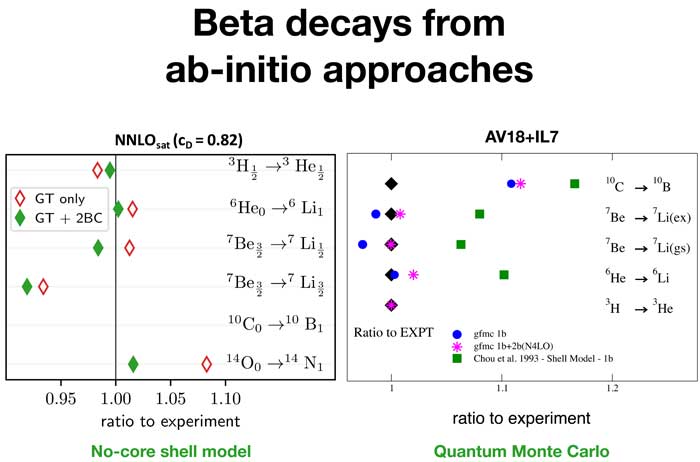 |

Ab initio nuclear theory have reached the degree of maturity to describe the structure and electroweak interactions of atomic nuclei. This paves the way to quantitative predictions on the interaction of neutrinos with nuclei, which span broad energy and momentum regimes. This is a required input for a quantitative study of fundamental symmetries and astrophysical processes.
As an example, neutrino oscillation experiments, currently relying on oversimplified models of nuclear dynamics, demand for accurate theoretical predictions for the neutrino-nucleus cross sections. In addition, the interpretation of present and planning of future neutrinoless ββ decay experiments need reliable values of the nuclear matrix elements that govern the decay. Current theoretical predictions suffer from large uncertainties, which could reach a factor of 10.
Among the highlights of our program, we find the following particularly relevant
Promising results for the structure of light nuclei and nuclear matter equation of state based on local chiral effective field theory potentials with and without explicit Delta resonances.
Test of nuclear saturation in medium-mass nuclei with the self-consistent Green's function method using new local-nonlocal chiral interactions.
Beta decays of light nuclei obtained from highly-sophisticated nuclear many-body approaches, such as the no-core shell model and the Green's function Monte Carlo were discussed. In particular:
An inconsistent effect of two-body currents (quenching from no-core shell model, enhancement from Green's function Monte Carlo) was identified.
The role of nuclear correlations and currents was disentangled in the analysis of the beta decay of medium-mass and heavy nuclei.
Relevance of electron scattering data to constrain neutrino-nucleus cross sections. Results for Ar-40 (used by the DUNE experiment) and Ti-48 from a recent JLab experiment have been presented.
Self-consistent Green's Function calculations of the nuclear spectral function for Ar-40 and O-16, both used in neutrino-oscillation detectors. Electron scattering calculations based on these spectral functions agree well with data.
A new method to extract the electroweak cross-sections from Quantum Monte Carlo simulations successfully tested on He-4.
Fruitful discussion on the relevance for ββ decay experiments of charge-exchange reactions. Muon capture identified as a promising path to test nuclear calculations at the momentum-transfer regime relevant for neutrinoless ββ decay.
|


